|
The images and descriptions below of canvas art paintings by masters were provided by Jock Stewart from Sydney. These masterpieces provide an insight into the the symbolism and significance of foods in work of art. There are two galleries
The Marvelous Sauce’, by Jehan Georges Vibert
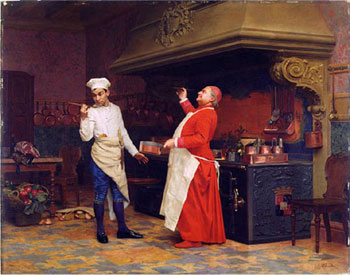
Clerical themes were popular subjects in the late nineteenth century and scenes such as The Marvellous Sauce, cantered in the kitchen, were common in the work of numerous artists. Everything about the scene, the large iron stove with elaborate hood and scrollwork, the numerous brass cooking pots, the abundance of food, the size of the room, and the patterned tile floor reflects the wealth of the household, which belongs to the man on the right. He is a cardinal, a high-ranking official in the Catholic Church. The coat of arms on the side of the stove implies that he is also a member of a noble family.
A drama is unfolding in this impressive kitchen. The cardinal himself, wearing an apron over his official red robe, has presumably prepared the sauce in the pot he holds. His exuberant gesture and the look of delight on his face imply great pleasure with the creation. The chef, who also has sampled the sauce, is perhaps of a different opinion.
In spite of the humorous nature of this painting, Vibert was gently criticizing the clergy. The size of the cardinal and his enthusiasm for the sauce might imply that he spends more time in the kitchen and dining room than he does in church carrying out his religious obligations.
Cook Maid with Vegetables by Nathaniel Bacon.
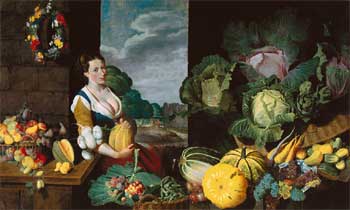
Nathaniel Bacon was particularly known for his extraordinary, large-scale kitchen and market scenes which were dominated by still-life depictions of enormous vegetables and fruit, and often included a buxom maid, which depicts a young woman, sitting by a window, surrounded by a bountiful harvest, the maid’s cleavage echoes the opened melon the table.
One art historian makes the point that whilst our immediate response as a modern Western audience might be to identify the painting as salacious (almost an early seventeenth-century version of the Page Three girl!, the critic insists that the painting is not meant to be read this way. Instead, he argues, that the woman represents Ceres, the goddess of plenty, and that the painting is an optimistic and life affirming celebration of abundance:
To produce abundance such as this, in a world where general famines occurred every decade, was to tiptoe back into Eden.
According to the critic, Cookmaid with Vegetables firmly asserts its faith in a world riddled with famine and poverty. By evoking the Garden of Eden, it invites us to celebrate the beauty of God’s creation, but by keeping the context firmly within a contemporary setting, Bacon is drawing on a tradition of ‘secular parables’. Like religious parables, they seek to ‘provoke, tease, challenge, illuminate and surprise’ but whilst affirming our faith, they are set firmly within the secular world:
Secular parables, then, are part of God’s revelation. They are this without losing their secular character or undergoing any inner transformation, without any question of transfiguration or transubstantiation. As part of the process, as part of God’s exercise of freedom, they acquire a function and capability as thus exercised which they did not have intrinsically.
For the critic Nathaniel Bacon’s painting is firmly part of this tradition, inviting us to reflect on the inherent beauty of the world we inhabit. It offers a glowing faith in the goodness of created order, a life-affirming counterpoint to a world of savagery, poverty and climate change.
Here are four paintings by Flemish artist Joachim Beuckelaer in his Four Elements series. Many of his paintings contain scenes of kitchen and markets, with religious allusions in the background.
1. Water A Fish Market with the Miraculous Draught of Fishes in the Background.
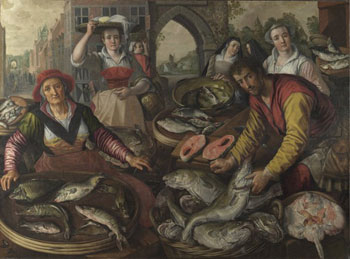
The artist has depicted twelve different identifiable varieties of fish. Some art historians believe that the twelve represent the twelve disciples. It is thought that he was the first painter to depict the market fish stalls at Antwerp. Before us we gaze at the stall holders and we start to feel a little uncomfortable with the way they stare out at us. The older lady to the left has a resigned expression on her face as if it is just another day selling fish. She is not smiling. She looks tired as she holds out the tray of fish for us to examine. The man to the right, who maybe her son, rests his right hand on a trestle table as he proudly shows us the underbelly of a large fish. It is interesting to look at the left background and see how Beuckelaer has used steep perspective in the way the artist depicts the bustling street going off into the distance.
However what is more fascinating and in some ways more bizarre is what we see though the central arch in the background. This is not part of the landscape to the rear of the fish market but is in fact a scene from the bible. It is the time when Christ appeared to the disciples. This was the third sighting of Christ since the Resurrection and the scene is based on the Gospel by Luke 5: 1-11, in which we are told that Jesus told the despondent fishermen, including Simon Peter, who were washing their nets after a fruitless days fishing, to put out to the deep water and once again let down their nets. Peter questioned the merit of this advice but did so and they caught innumerable fish and this has been referred to as the Miracle of the Fishermen.
To get a much better view of this painting I suggest you try the National Gallery Website (below) and then you can zoom in on aspects of the painting. The website is:
http://www.nationalgallery.org.uk/paintings/joachim-beuckelaer-the-four-elements-water.
2. Earth. A Fruit and Vegetable Market with the Flight into Egypt in the Background.
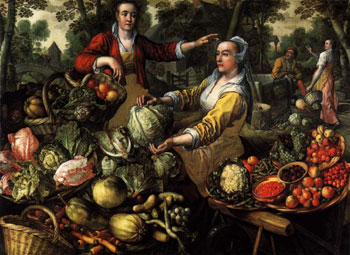
This is the second in the series entitled Earth. A Fruit and Vegetable Market with the Flight into Egypt in the Background. In this painting we are again standing in front of a market stall. This time the scene is set in the countryside, outside a large thatched-roof farmhouse, and before us we can see laid out an abundance of fruit and vegetables, symbolizing Earth. as this is where the produce has come from. It was common practice in Dutch and Flemish paintings of the 16th and 17th century to symbolize the Elements by reference to the natural world. There are sixteen different varieties of fruit and vegetables on display in the painting. The artist has used some artistic licence when he painted the various fruit and vegetables as not all would be available at the same time of year and of course there was no such thing as refrigeration in the seventeenth century. It is truly a depiction of a land of plenty where there is no place for hunger.
The spectrum of colours used by the artist has enhanced the painting. The fruit is painted with such realism. They look so succulent and they lay there tilted slightly towards us to give us an even better view of everything and tempt us to try some of the produce. You almost want to move forward and pick a grape or sample a mulberry. All seems so mouth-watering which is a testament to the artist’s great ability to paint still-life subjects.
It is difficult to decide who are the buyers and who are the sellers in the painting. Before us, we have the two young females in their colourful attire. The lady in the red jacket with her sleeves rolled up has rosy cheeks which has probably come from working outside so much. The lady with the lace cap and yellow sleeved dress would seem to be dressed slightly better than the others and may hold the position of head cook in a wealthy household who has come down to choose the best produce for the ingredients needed for the meals she is about to prepare. I love the way the way Beuckelaer depicts the vegetables tumbling from her hands. It makes you almost want to rush forward and catch the errant cabbage before it hits the ground. To the right of the main figures we see a young man and woman by a well and one wonders if they are the stall holders who use the water from the well to wash the fruit before putting it on display. The man stares out at us with his elbow on the edge of the well as he takes a rest.
Once again the artist has included a scene from the bible into the painting. Look to the left background and you can see in the distance, a small arched bridge, on which Mary and Joseph are crossing. Joseph leads the way on foot guiding the mule on which sits Mary with the infant Jesus and is a portrayal of the Holy Family’s Flight into Egypt to avoid the clutches of King Herod.
I love this painting and I love how Beuckelaer has painted the produce. It is so life-like. The colours he has used enhance the painting and make it look so real.
To get a much better view of this painting I suggest you try the National Gallery Website (below) and then you can zoom in on aspects of the painting. The website is:
http://www.nationalgallery.org.uk/paintings/joachim-beuckelaer-the-four-elements-air.
3. Air. A Poultry Market with the Prodigal Son in the Background.
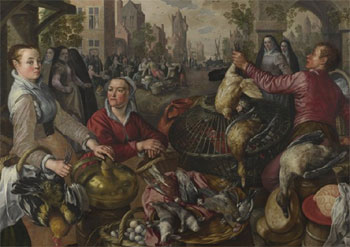
Here we look at the third painting of the set with the subtitle Air. A Poultry Market with the Prodigal Son in the Background.
In the Water painting we were shown a fish market and the connection with the Element of Water was that of the habitat of the food. The same went for the Earth painting when we saw the fruits and vegetables of the earth. Here the subject is Air where we are treated to the sight of the food which occupies the air above ground, namely birds, fowl and rabbits. We are also treated to the sight of products which come indirectly from the land such as eggs and cheeses. We are at a poultry market and there is an abundance of food on offer. During Beuckelaer lifetime he painted numerous market scenes and at that time the art market was flooded with such a genre.
In the painting we see the rosy-cheeked stall holder sitting alongside the produce. It is a well-stocked market stall with a variety of dead fowl and small birds. We can also see inside a green wicker cage some live hens. The man at the stall, wearing the leather jerkin, has hold of a hen by its feet having just taken it out of the cage to show it to a would-be purchaser. To the left we observe a well dressed woman. She too is holding a hen in her right hand whilst her left hand rests atop a copper flagon which may contain milk or wine.
In the central background we see a road leading to the sea with a small cargo boat just setting sail with the crewman starting to hoist the sails. On the quay we can just make out some barrels which have been offloaded from the craft.
So where is the Biblical story, which the artist is known to have incorporated into each of the four paintings? In this painting it is not as obvious. If however you concentrate on this road leading to the sea you will spot on the left hand side just behind some baskets of produce a man and a woman. She has her hand on his arm greeting him. He is leaning backwards against her, almost slumped. This was the Biblical addition of the painting by Beuckelaer, symbolizing the Prodigal Son returning home. it seems as if he is inebriated and has just about made it back home.
This is a a very colourful painting, full of activity. I get great pleasure looking around the painting at the various characters and their expressions and try and work out what is happening and what the artist had in his mind as he put paintbrush to canvas.
To get a much better view of this painting I suggest you try the National Gallery Website (below) and then you can zoom in on aspects of the painting. The website is:
http://www.nationalgallery.org.uk/paintings/joachim-beuckelaer-the-four-elements-air
4. Fire. A Kitchen Scene with Christ in the House of Martha and Mary in the Background.
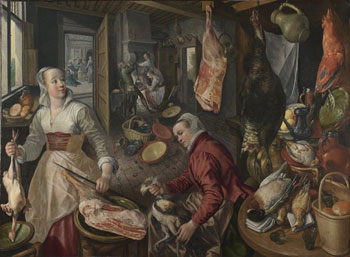
This painting moves away from the market stalls where we saw women buying vegetables, poultry and fish and that were featured in the previous three works of art. Here, we move to a kitchen scene in which the produce that has been bought at the various market stalls will be cooked. To do the cooking one needs fire, hence the subtitle to this painting.
This painting, like the other three was completed in Beuckelaer’s studio for an Italian patron. The abundance of food in the paintings did not mirror life in the Netherlands at the time as the locals lived under the oppressive regime of the Duke of Alba, a Spanish general who was the governor of the Spanish Netherlands and who was renowned for his cruelty and atrocities against the Flemish and Dutch people.
We look at the kitchen scene from a slightly elevated position. This is a busy kitchen. Probably more than just busy, I think it borders on disarray, almost chaos by the look at the tumbling kitchen bowls in the centre of the composition. Whilst the women are hard at work, the only male in the picture, who is probably a servant or steward drinks to excess and if not careful will end up in the fire! The two women with him seem less than amused at his antics. Look carefully at the produce. See how Beuckelaer has exquisitely painted the various dead poultry and the sides of ham. No detail has been spared. Look at the way he has painted the earthenware kitchen utensils, some glistening in the sunlight which streams through the kitchen window.
On the floor we can see mussel shells. These sometimes have erotic connotations when seen in paintings. However there may be another meaning to the scattering of these shells in the kitchen scene. The Dutch Golden Age painter of allegories, Adriaen van de Venne said that because mussels stay in their shells they can be compared to the blessed women-folk who speak modestly and virtuously and always look after their household. So maybe Beuckelaer’s inclusion of the shells on the floor was a tribute to the hard working women in his kitchen scene.
Finally if you look through the door on the left-hand side, you can see another kitchen scene. This is the Biblical story which Beuckelaer has introduced into each of his four paintings. This scene is set in the kitchen of the house of Mary and her sister Martha in which we see Jesus who has come to visit them. The story according to the Bible is that Martha complains to Jesus that although she is working hard in the kitchen, all Mary does is stand around listening to his words. Jesus reproached her saying that Mary’s contemplation was in fact a more important form of her work.
This biblical story was often told to servants in the sixteenth century with sole purpose of stopping them complaining about the amount of servile work they had to carry out. I am not sure that this parable would find much favour in present day workers!
To get a much better view of this painting I suggest you try the National Gallery Website and then you can zoom in on aspects of the painting. The website is:
http://www.nationalgallery.org.uk/paintings/joachim-beuckelaer-the-four-elements-fire.
The Butcher’s Shop by Annibale Carracci.
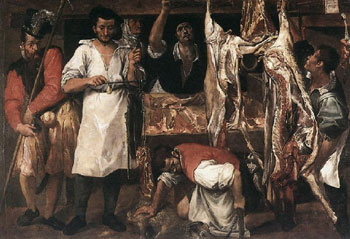
This painting by Annibale Carracci does not represent a specific subject from literature or mythology, but simply a scene from everyday life. Here, Carracci shows the four main activities that take place in a butcher’s shop: slaughter, the dressing of the meat, the weighing of the meat and finally the purchase by the consumer.
Some art historians hold that The Butcher’s Shop could have been executed for the powerful Butcher’s Guild of Bologna, or for the influential and wealthy Canobi family, who owned a chain of butcher and livestock shops in the city.
The Butcher’s Shop Analysis:
As with most of his paintings, Carracci’s preparation for The Butcher’s Shop was extensive.
Here, the precisely depicted meats as well as the realistic poses of the butchers bespeak an intent observation of nature.
The boyish model is most likely a workshop apprentice and his pose is carefully studied. The artist’s butchers are depicted as dignified, upstanding men, not dirty, mentally-challenged laborers. Their aprons are spotlessly white and their poses are graceful and dignified. They don’t engage with the viewer, but are instead absorbed in their work.
Further emphasizing the high status of his figures, the pose of the kneeling butcher in the centre of the composition is a direct quotation from Raphael’s The Sacrifice of Noah which was known to the artist from an engraving.
In Carracci’s composition, it is the customers who are the artist’s target, not the butchers. Note how the Swiss halberdier awkwardly juggles his staff as he reaches for his change across a surprisingly prominent codpiece, suspiciously glaring at the butcher to make sure he is weighing the meat correctly.
The old crone buying meat in the back of the composition is similarly ridiculous. She gazes at the butcher fetching her order with an almost lascivious avidity.
Carracci employs a sober palette limited to earth tones. The fleshy reds and browns of the meat dominate the entire canvas, with the exception of the bright white of the butchers’ smocks.
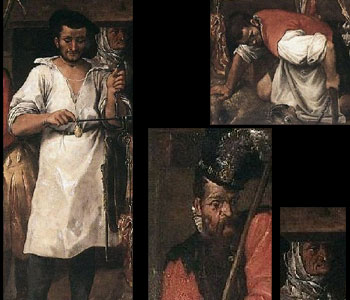
These two paintings (The Butcher’s Shop and the Fishmonger’s Shop) were originally part of a series of four. There are close stylistic connections between these canvases and the works of the Dutch masters Aertsen and Beuckelaer, as well as with the Butcher’s Shop by Annibale Carracci.
The Butcher’s Shop by Bartolomeo Passerotti.
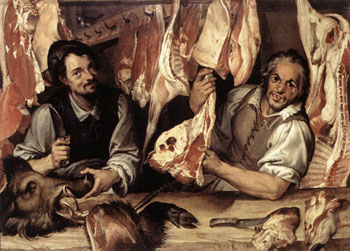
Passerotti describes the butcher’s shop with a combination of realistic precision in the rendering of details and irony in the characterization of the people. In late sixteenth century art the theme of the butcher shop was moralistically interpreted as an allegorical warning about the temptations of flesh and of indulgence in erotic passions without caution. According to the counter-reformation precepts laid down by Gabriele Paleotti (1582), veiled moral messages could be transmitted through comical pictures.
In both pictures the sparrow appears: as this bird’s Italian name is the passerotto. The artist used it as a type of pictorial signature.
The Fishmonger’s Shop by Bartolomeo Passerotti.
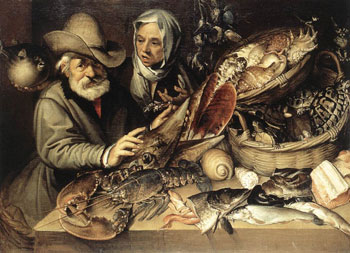
The fish shop is rich with the most minute naturalistic description, with the woman holing up the blowfish and with various types of sea shells on display reflecting Passerotti interest in naturalistic study. A participant in the scientific culture of Bologna. Passerotti created his own varied collection of curiosities and monstrosities.
In both pictures the sparrow appears: as this bird’s Italian name is the passerotto. The artist used it as a type of pictorial signature. Looking for the sparrow can be as much fun as children have trying to find Wally.
Kitchen Scene by Joachim Beuckelaer.
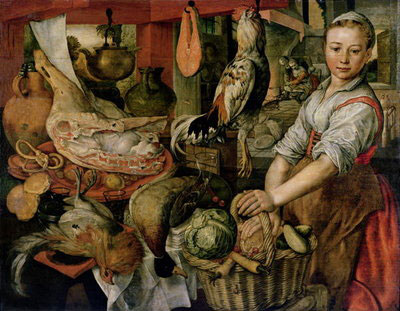
The scene takes place in a large room suggestive of the kitchen of a castle or noble country residence. The foreground depicts a pantry full of foodstuffs. A mallard duck lies on top of a pile of napkins, with a hen to the left. A cockerel hangs from a beam, next to a salmon steak. The table, in the foreground to the left, is laden with a large dish containing chestnuts and fruit, including a lemon, an exotic luxury in northern Europe at the time. A leg of veal lies on top of everything else, surrounded by storage jars. Above it we see a metal cooking-pot, hanging from a beam, silhouetted against an open view of a landscape in the background. The right-hand side of the picture is dominated by the figure of a serving-girl, just back from a visit to the market, carrying a basket of vegetables and fruit: a cabbage, carrots, cherries and gherkins. Behind her, we see a huge room with a large fireplace. A cook is pouring sauce over a piece of poultry cooking on a spit. A brazier is heating up under her skirts, and she is being fondled by the figure of an old man.
The heap of foodstuffs fills almost half of this colourful composition. The still-life itself is framed by the red of the beams, and the serving-girl’s dress. The composition is also punctuated by large areas of white, from the laundry hanging in the top left-hand corner, to the pile of napkins, and the serving-girl’s blouse. The careful scene-setting, and the organization of the colours, contribute to the painting’s “aesthetic of opulence.” But as so often in large “kitchen pieces” of this type, the everyday scene expresses a moral message, too. In all of the kitchen pieces attributed to Joachim Beuckelaer (and his uncle and master Pieter Aertsen) the protagonists seem gripped by a kind of frenzied sensuality. Some contemporary commentators identified the serving classes’ daily physical contact with foodstuffs, and the heat of the kitchens, as the root causes of their apparently unbridled sensuality and excess. This is clearly expressed in the scene depicted in the background of the picture, and may also be implicit in the representation of the serving-girl’s hand, resting on the rounded form of the cabbage.
Butcher’s Stall with the Flight into Egypt by Pieter Aertsen
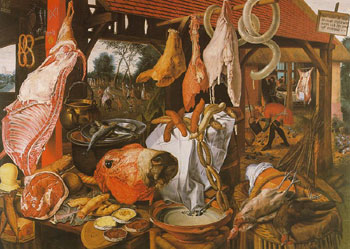
In the 16th and 17th centuries it was quite common for theologians to see a slaughtered animal as symbolizing the death of a believer. Allusions to the ‘weak flesh’ (cf. Matthew 16:41) may well have been associated with Aertsen’s Butcher’s Stall where – like on his fruit and vegetable stalls – a seemingly infinite abundance of meat has been spread out.
In the foreground tables, pots, plates, a barrel, some wickerwork chairs and baskets serve as supports and containers for huge hunks of meat, pig’s trotters, soups, chains of sausages hanging down and freshly slaughtered poultry. In the background there is an open, shingle-roofed studded stable with a pole from which further pieces of meat are suspended, including a pig’s head, a twisted sausage and some lard. Through the stable we can see a garden scene. On the right, in the middle ground, a farmer is filling a large jug, and behind him we can see a slaughtered and gutted pig, a motif which Beuckelaer also used as an independent motif.
The Kitchen Maid by Pieter Cornelisz van Rijck.
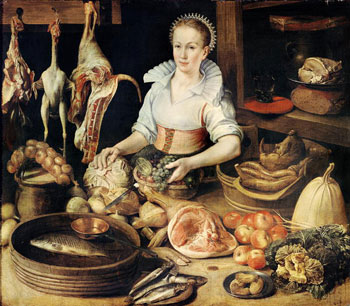
The painting shows a central female figure in a larder surrounded by still-life elements. She poses with her hand on a cabbage , a common erotic allusion i in paintings of this kind.
Kitchen Still Life by Pieter Cornelisz van Rijck.
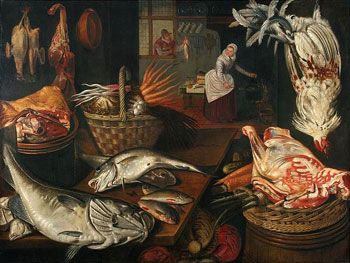
This painting fascinates me because all the different types of meat, fish, vegetables, game birds hanging and the fishmonger trying to sell the cook some fresh fish through the open window.
Market scene. Pieter Cornelis
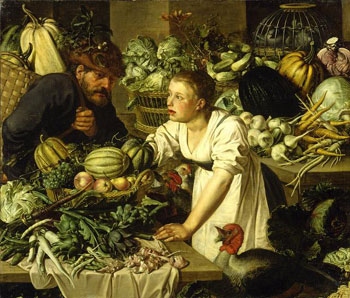
Sausage-Making by David Teniers the Younger.
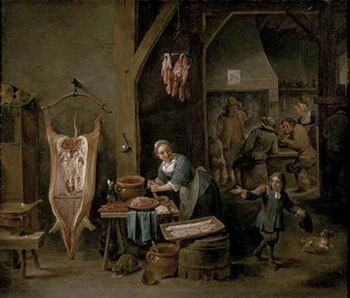
Here we see the cook making sausages with the intestines of the pig, which has been cut wide open for all to see and a cat enjoys some of the trimmings.
Luncheon of the Boating Party by Auguste Renoir.
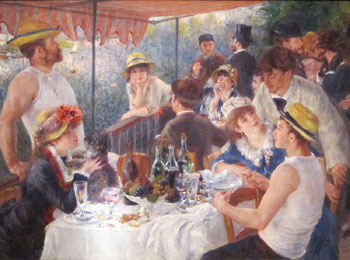
Renoir shows a group of young people who have obviously enjoyed their lunch and are relaxing on a balcony at the Maison Fournaise along the Seine river in Chatou.
The painting reflects the changing character of French society in the mid- to late 19th century. The restaurant welcomed customers of many classes, including businessmen, society women, artists, actresses, writers, critics, seamstresses, and shop girls. This diverse group embodied a new, modern Parisian society.
There are many ways to break this painting up and one of the things to focus on is the food and drink that the people are consuming.
The diagonal of the railing serves to demarcate the two halves of the composition, one densely packed with figures, the other all but empty, save for the two figures of the proprietor’s daughter Louise-Alphonsine Fournaise and her brother, Alphonse Fournaise, Jr, which are made prominent by this contrast. In this painting Renoir has captured a great deal of light. The main focus of light is coming from the large opening in the balcony, beside the large singleted man in the hat. The singlets of both men in the foreground and the table-cloth all work together to reflect this light and send it through the whole composition.
As he often did in his paintings, Renoir included several of his friends in Luncheon of the Boating Party. Among them are the following:
*The painter and art patron, Gustave Caillebotte, is seated in the lower right. Renoir’s future wife, seamstress, Aline Charigot, is in
the foreground playing with a small dog.
On the table is fruit and wine.
* Charles Ephrussi wealthy amateur art historian, collector, and editor of the Gazette des Beaux-Arts appears wearing a top hat in
the background.
*The younger man to whom Ephrussi appears to be speaking, more casually attired in a brown coat and cap, may be Jules
Laforgue, his personal secretary and also a poet and critic.
*Actress Ellen Andre drinks from a glass in the center of the composition. Seated across from her is Baron Raoul Barbier.
*Placed within but peripheral to the party are the proprietor’s daughter Louise-Alphonsine Fournaise and her brother,
* Alphonse Fournaise, Jr., both sporting traditional straw boaters and appearing to the left side of the image. Alphonsine is the
smiling woman leaning on the railing;
*Alphonse, who was responsible for the boat rental, is the leftmost figure.
*Also wearing boaters are figures appearing to be Renoir’s close friends Eug ne Pierre Lestringuez and Paul Lhote, himself an
artist. Renoir depicts them flirting with the actress Jeanne Samary in the upper righthand corner of the painting.
In the right foreground, Gustave Caillebotte wears a white boater’s shirt and flat-topped straw boaters hat as he sits backwards in his chair next to actress Angle Legault and journalist Adrien Maggiolo. An art patron, painter, and important figure in the impressionist circle, Caillebotte was also an avid boatman and drew on that subject for several works.
A Bar at the Folies-Bergere by Douard Manet.
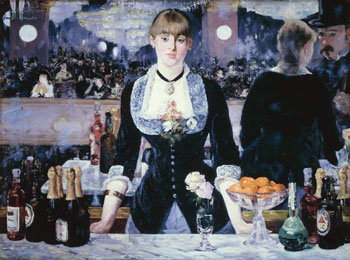
The painting is filled with fascinating details specific to the Folies-Berg�re. The distant pair of green feet in the upper left-hand corner belong to a trapeze artist, who is performing above the restaurant’s patrons.
The beer which is depicted, Bass Pale Ale (noted by the red triangle on the label), would have catered not to the tastes of Parisians, but to those of English tourists, suggesting a British clientele. Manet has signed his name on the label of the bottle at the bottom left, combining the centuries-old practice of self-promotion in art. One interpretation of the painting has been that far from only being a seller of the wares shown on the counter, the woman is herself one of the wares for sale; conveying undertones of prostitution. The man in the background may be a potential client.
But for all its specificity to time and place, it is worth noting that, should the background of this painting indeed be a reflection in a mirror on the wall behind the bar as suggested by some critics, the woman in the reflection would appear directly behind the image of the woman facing forward. Neither are the bottles reflected accurately or in like quantity for it to be a reflection. These details were criticized in the French press when the painting was shown. The assumption is faulty when one considers that the postures of the two women, however, are quite different and the presence of the man to whom the second woman speaks marks the depth of the subject area. Indeed many critics view the faults in the reflection to be fundamental to the painting as they show a double reality and meaning to the work. One interpretation is that the reflection is an interaction earlier in time that results in the subject’s expression in the painting’s present.
According to some of Manet’s friends the woman is known as Suzon, a young woman who worked at the Folies-Bergre
Suzon stands alone in a crowded room. The look on her face is detached, melancholy, distracted from her job serving at the bar in the vast crowded room reflected in the glass behind her. There is a locket around her neck that is a token of another life, a love a long way from this job.
This is an unusual portrait because it is of someone at work, and someone who to our eyes is defined by her work and is profoundly unhappy with it. She is alienated from her surroundings, as if there is a glass pane between her and everyone else in the room – the drinkers, chatters-up, lovers, liars, thieves and businessmen. Manet conveys Suzon’s estrangement from her world by the fact that she is the only person in this painting who is not reflected in glass. Everyone else in the painting is seen in the big bar mirror: the quickly painted, harshly reflected faces and bodies, a woman in gloves with her lover or client, someone else looking at the scene with binoculars. They are objects she is looking at – but at one remove, through a glass darkly.
The only solid realities are the marble bar top and the bottles – creme de menthe, champagne, beer – a bowl of oranges, two flowers delicately placed in a vase. She has both hands firmly on the bar as if she needs to touch something solid, in case she should be carried away by the vortex of light and shapes reflected in the mirror.
This is not a realistic painting of the Folies-Bergre. Suzon did work there, but she posed for the painting in Manet’s studio, behind a table laden with bottles. He merged this image with rapid painted sketches he made at the Folies-Bergre. There is no attempt to make the image cohere: there is, as contemporary critics pointed out, an inconsistency to the relationship between the reflections in the mirror and the real things. The man in the top hat approaching Suzon in a sinister way in the top right hand corner of the mirror would in reality have to be standing with his back to us in front of the bar, and Suzon herself should be reflected in an entirely different place.
Cafe des Incoherents by Santiago Rusinol.
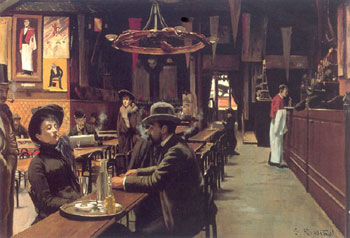
I love this painting mainly because of the name of the cafe, and it reminds me of many of the cafes that I used to go to in Montmartre. The cafe is at 16 bis, rue Fontaine, Montmartre.
The artist, Maurice Utrillo is in the background reading a newspaper, and Casas sits in the foreground at a long wooden table, mesmerized by the young woman opposite him.
Whenever I see paintings such as the next two I imagine that it must have to clients such as these that Escoffier served meals to at the Savoy and Ritz hotels at the turn of the last century.
The End of Dinner by Jules Alexandre Grun.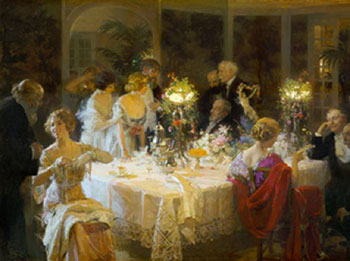
The above work is also referred to as “The Dinner Party”, for obvious reasons. It depicts Grun, his wife, and a number of their friends (including Jules Cheret and Antoine Guillemet) engaged in after dinner revelry. Guillemet is sitting on the right hand side of the painting, leaning on his hand. He is facing (and talking to) Grun’s wife Juliette Toutain-Grun. You can see Cheret and Grun in the back/middle of the painting, Grun slightly obscured by Cheret.
After Dinner.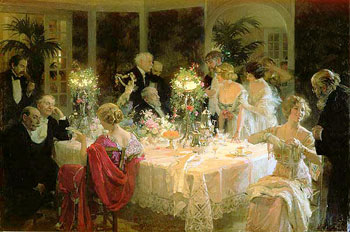
Apples and Oranges by Paul Cezanne.
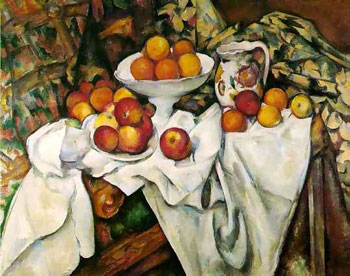
This is one of the most sumptuous of all of Cezanne’s still-life’s. The complex arrangement of fruit, dishes, jug and drapery on a table which slopes dramatically upwards from the left is given stability by the zigzag line created by the edges of the white table cloth. The focal point of the painting, the solitary apple at the front of the table, is at the geometrical centre of the picture plane, where the two diagonals cross. The main objects are arranged roughly in a triangle or pyramid with its base resting on a horizontal line just below the midpoint which might also coincide with the tabletop.
The Kitchen Table by Paul Cezanne.
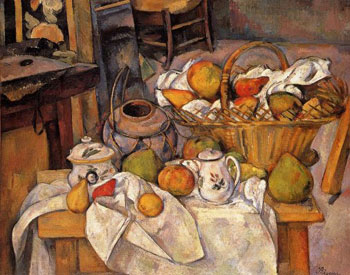
This is an interesting painting because the artist pushes the table and cloth close to the viewer, cropping them at the bottom. Individual pots sit uneasily on an impossibly tilted plane of table-top. The grey ginger-pot has no surface to sit on, and neither has the large basket at the back. But they demand their space, painted from above , or front-on, as the composition requires. Similarly, the table, cupboard and chair line up diagonally on the left, none holding any probable perspective. A wooden leg intrudes on the right, casting an unbelievable shadow, and belong to what? It could belong to an errant stool, or ladder leg perhaps. But compositionally, it continues the frame around the objects which begin in the lower-left corner with the table edge, and is taken up by the line where the back wall meets the floor. The internal frames compress the composition even further, and force an overall lozenge shape.
Yet each distorted element has its convincing volume, with a glorious harmony of red, green and yellow fruit. Warm hues of wood and cane contrast with the cooler white, grey and purple of cloth and ceramics. The loop of the ginger-pot is repeated larger in the basket handle, smaller and vertically in the handle of the coffee-pot, accentuating the rounded shapes of the fruit. All these circular forms cascade diagonally down the canvas, through the folds of the two white cloths which double and then unify the composition. Kitchen Table is a very rich and variously populated still-life in Cezanne’s painting out-put, with details such as the floral decoration on the china coffee jug repeated on the round pot, then written large in the flower painting on the wall.
Some of the objects in these painting are still preserved in Cezanne’s Chemin des Lauves studio, Aix, France.
The Kitchen Table by Andre Derain.
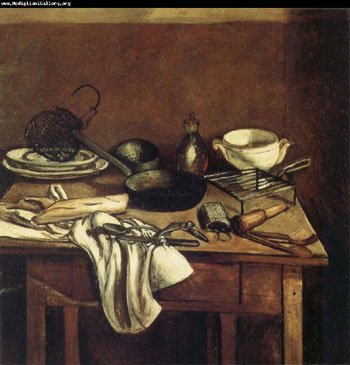
This painting is one of the best known examples of kitchen utensils. The composition is formed by two opposed triangles with apexes merging at the centre of the frying pan. The upper triangle holds the rounded objects, the lower one the long flat objects. These items correspond to each other from left to right; the black lettuce basket and the white soup plate; the loaf of bread repeating the shape and colour of the wooden corkscrew; the iron wires of the lettuce basket repeating the rods of the grill.
The Brioche by Jean Chardin
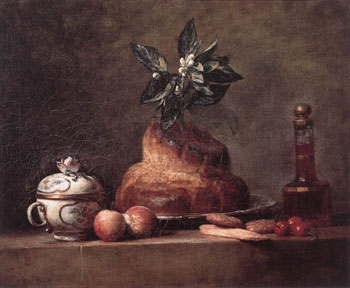
Jean Chardin was one of greatest masters of Still Life in the history of art. The items he portrayed from his own home were selected for their shapes, textures and colours, rather than for any symbolic meaning they may have had. They were simply painted to convey the visual pleasure he experienced in looking at them. Chardin’s paintings appeal greatly to modern eyes accustomed to the simplified forms of Cezanne, and the Cubists. They all share the same ideals: a unified composition reached through the analytical drawing of pure forms, uncluttered by emotion and without any superfluous detail.
Nighthawks by Edward Hopper.
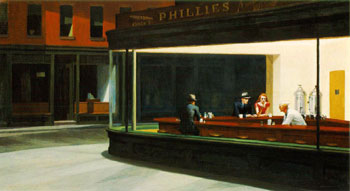
This painting Nighthawks is considered Hopper’s most famous painting, as well as one of the most recognizable in American art.
I really like the vast array of colours used in the painting Night + brilliant interior of cheap restaurant. Bright items: cherry wood counter + tops of surrounding stools; light on metal tanks at rear right; brilliant streak of jade green tiles across canvas at base of glass of window curving at corner. Light walls, dull yellow ochre door into kitchen right.
There is a very good looking blond boy in white (coat, cap) inside counter. Girl in red blouse, brown hair eating sandwich. Man night hawk (beak) in dark suit, steel grey hat, black band, blue shirt (clean) holding cigarette. Other figure dark sinister back at left. Light side walk outside pale greenish. Darkish red brick houses opposite. Sign across top of restaurant, dark Phillies 5c cigar. Picture of cigar. Outside of shop dark, green. Note: bit of bright ceiling inside shop against dark of outside street at edge of stretch of top of window.
I really like the solitude of the patrons. It reminds me of being in a bar late at night /early morning and just being there.
Here is an establishing shot from “Homer vs. The Eighteenth Amendment”, one of several references to Nighthawks in the animated TV series The Simpsons in 1997
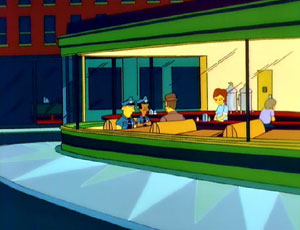
This painting would have to be the most famous painting about food, as we see in Leonardo da Vinci’s The Last Supper, Christ celebrating his last meal with his disciples before his death.. This painting is one of the artist’s most well-known works and, together with the Mona Lisa, was one of the two paintings that helped establish Leonardo’s fame as a painter. The work was commissioned by the Duke Lodovico Sforza, Leonardo’s patron, for the refectory (dining hall) of the convent of Santa Maria delle Grazie, in Milan, Italy.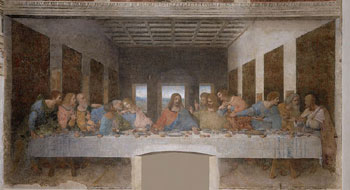
This copy by an unknown artist of the 16th century is a copy of Leonardo’s Last Supper. It is almost as large as the original and displays a wealth of detail, which is no longer visible in the Leonardo’s wall-painting due to the extensive damage it has suffered.
It can be seen in the Da Vinci Museum, Abbey of Tongerlo, Tongerlo, Belgium.
The wall painting, which Leonardo worked on between 1495 and 1498, is not a true fresco. The painter chose not to paint the piece on wet plaster, since that would severely limit the amount of time he could spend on the work. Instead he sealed the stone wall with a layer of resin and then painted over the sealing layer with tempera. Unfortunately, though this technique allowed him to depict the scene in exquisite detail, it did not prove very durable. The piece began deteriorating within a few years of it being finished.
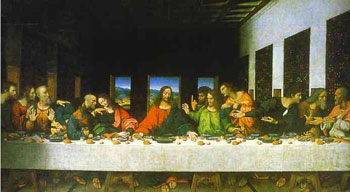
Scene Composition:
The finished size of the painting was 4.6 by 8.8 meters (roughly 15 by 29 feet). While the theme was a traditional one for refectories of the time, Leonardo’s realistic style and dramatic depiction of the figures imbued the work with much more realism and depth, influencing all later paintings of the Last Supper. Specifically, Leonardo’s work shows the moment after Jesus has announced that one of those sitting at the table will betray him (this episode is described in Matthew 26:21-22; Mark 14:18-19; Luke 22:21-23; and John 13:21-22). The twelve apostles react with various degrees of outrage and shock.
The lines of perspective meet in Christ’s right eye, thus making him the central figure of the painting. The rest of the scene is organized in order to emphasize this centrality. Leonardo grouped the apostles into four groups of three, with Jesus in the middle. From left to right are, they are:
Group One: Bartholomew, James the Lesser and Andrew form the first group of three, all of them appearing surprised. Andrew holds both of his hand up in front of him in a frightened gesture.
Group Two: Judas Iscariot, Simon Peter and John form the second group of three. Judas is holding a bag of silver in his right hand, while reaching for a piece of bread with his left. Simon Peter is leaning over the shoulder of John, a knife held in his right hand, symbolizing his zealous defence of Jesus. John appears to be swooning.
Prior to Leonardo, it had been traditional to isolate Judas from the rest of the apostles by either seating him across the table from Jesus, apart from the others who were traditionally depicted as sitting on only one side, or by giving all the rest of the apostles and Jesus haloes, and excluding Judas. Leonardo created a more subtle and thus dramatic effect by swathing Judas in shadow. He also presented a realistic explanation of Christ’s prophetic words that the first man to share bread with him would also be the betrayer: Jesus and Judas are shown reaching for the same piece of bread, although everybody’s attention is riveted elsewhere.
Group Three: The third group is made of Thomas, James the Great and Phillip. These three appear in varying degrees of shock; Thomas, with his hand raised, and Phillip seem to be requesting some sort of explanation, while James the Great, between them, appears to be recoiling from Jesus in horror.
Group Four: The last three, Matthew, Jude Thaddeus and Simon the Zealot appear to be discussing the matter with each other, in a rendition of Luke 22:23: “They began to question among themselves which of them it might be who would do this.”
Despite the theory popularized by Dan Brown in his popular novel, The Da Vinci Code, most scholars agree that the figure next to Jesus is John. The notebooks of Leonardo da Vinci name all of the disciples in the order in which they are shown (which is how we come to identify them) and all of the figures in Leonardo’s original sketches have distinctly male faces. It had been traditional to depict John as boyish and even effeminate, as he was the youngest and supposedly most devoted of Christ’s apostles. It has been reported that the first person to be painted was Jesus, the person used was a young priest from the local seminary, when Leonardo da Vinci was looking for a person to use as Judas he chose an beggar in Naples who told Leonardo that he had already been chosen for the painting and that he was the person chosen to portray Jesus. This just shows how cruel life can be.
|




























